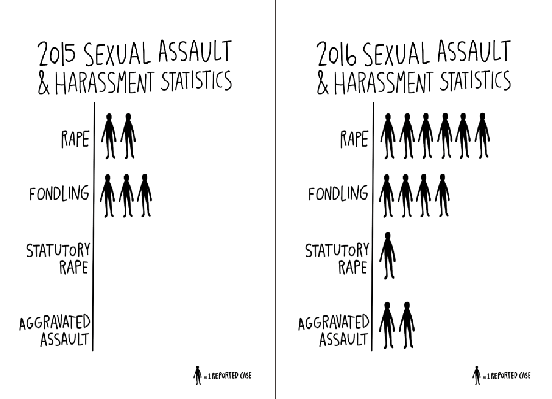UTSA’s 2017 Annual Security and Fire Safety Report, listed five incidences of rape on campus, one incident of rape off campus, four incidences of fondling and one incident of statutory rape were made at UTSA’s main campus in 2016. In 2015, two incidences of rape and two reports of fondling were made at Main Campus, and one incident of fondling were made at Downtown Campus.

Leonard Flaum, director of the UTSA Equal Opportunity Services (EOS) and Title IX coordinator, said more students are going to EOS to report sexual violence since the #MeToo movement.
“The majority of students that come to us, they are not coming to us to use our process to find someone responsible,” Flaum said. “They are coming to us to get assistance so they can succeed in school, because the majority of our sexual violence issues don’t occur on campus, and the perpetrator is not a student.”
Any student who has been assaulted —on or off campus—can go to the EOS and Title IX office for services.
“That can be in the form of academic relief, meaning that if the student has to miss classes because of what happened or they have to have medical appointments, court dates, if psychologically they are having difficulty concentrating on their school work, they can come to us,” said Flaum.
The EOS will contact faculty to ensure that students who are victims of sexual assault do not suffer academically.
The University’s Title IX process is used to investigate student-on-student incidents to determine if the assault occured and, if so, to hold the assaulter responsible.
“Sexual violence is considered a form of sexual harassment. The university has a sexual harassment policy: under the sexual harassment policy, we can find someone responsible, and then that student would be sent to student conduct,” said Flaum.
For student-on-student incidents, the first part of the investigation is getting the story from the victim. The next step is getting the story of the accused, giving him or her a charge letter and giving him or her the opportunity to respond to the accusation.
“Both students can submit evidence and provide us with witnesses. We’ll interview those witnesses, and we’ll take all of that information, and we then make a determination using a preponderance of evidence standard,” said Flaum.
The preponderance of evidence standard has been used in investigating sexual assault cases at UTSA since 2011.
Once the EOS makes a determination, the accused is referred to the Student Conduct and Community Standards (SCCS) and is placed in front of a review board who reviews the EOS investigation. The accused has the option of accepting responsibility for the charge or electing a hearing where the evidence is presented to a hearing officer.
The EOS can take measures to separate the students to ensure the accused does not come in contact with the victim during the investigation. “We still have to give all our students due process, so the person that is accused still has rights, so yes we’ll take them out of the classroom, but what we’ll do is we’ll arrange with the faculty member a way for them to complete the course work.”
UTSA police responds to sexual assault that occurs on campus and will help students report assault to the San Antonio Police Department if the incident happens off campus. UTSA police can also transport students to the hospital for an exam and contact the Rape Crisis Center to assist students who have been assaulted off campus.
“We have a very good support system here on campus; faculty, staff, the advising center, all of those offices work with us to assist our students,” said Flaum.
Students seeking help, contact the EOS and Title IX Office in the North Paseo Building 5.130 or visit their website, utsa.edu/eos, for more information.


